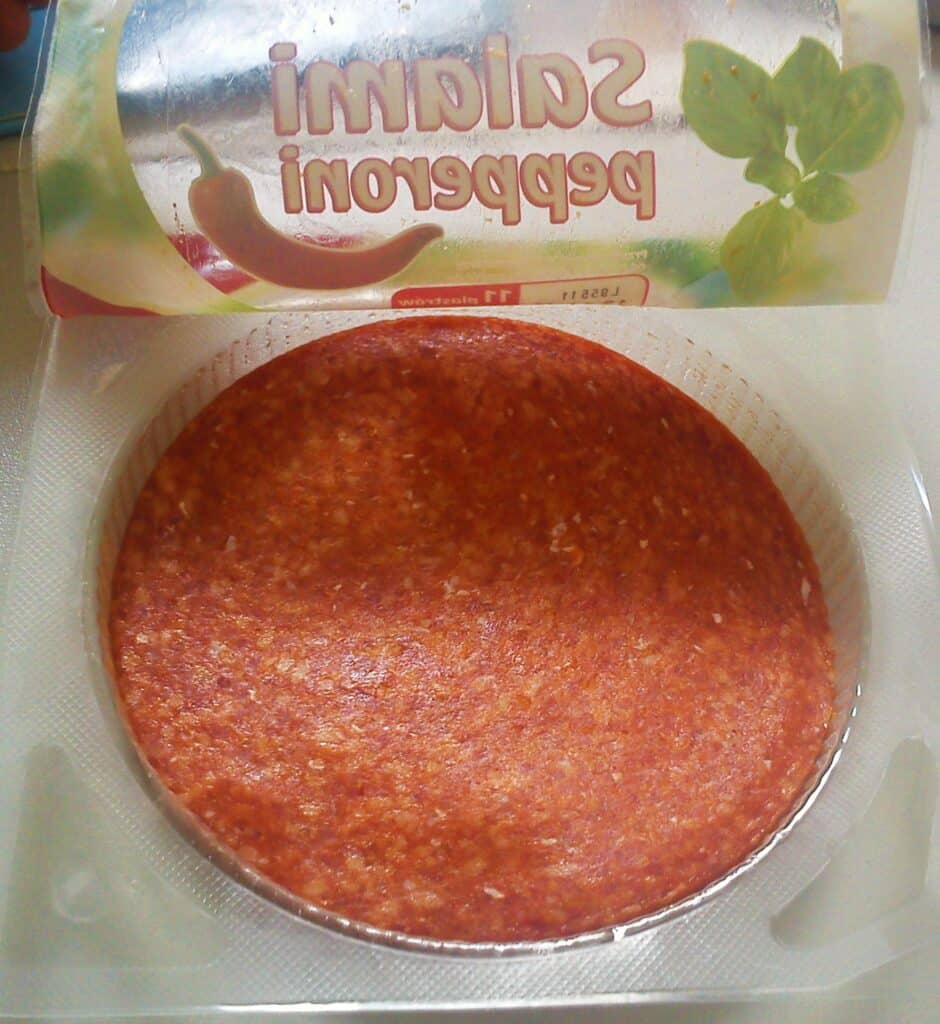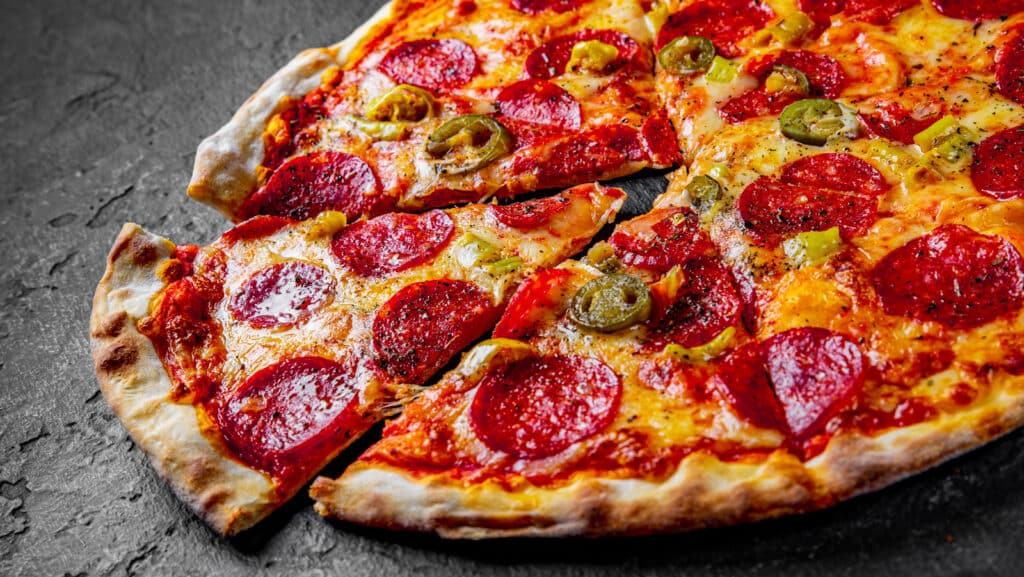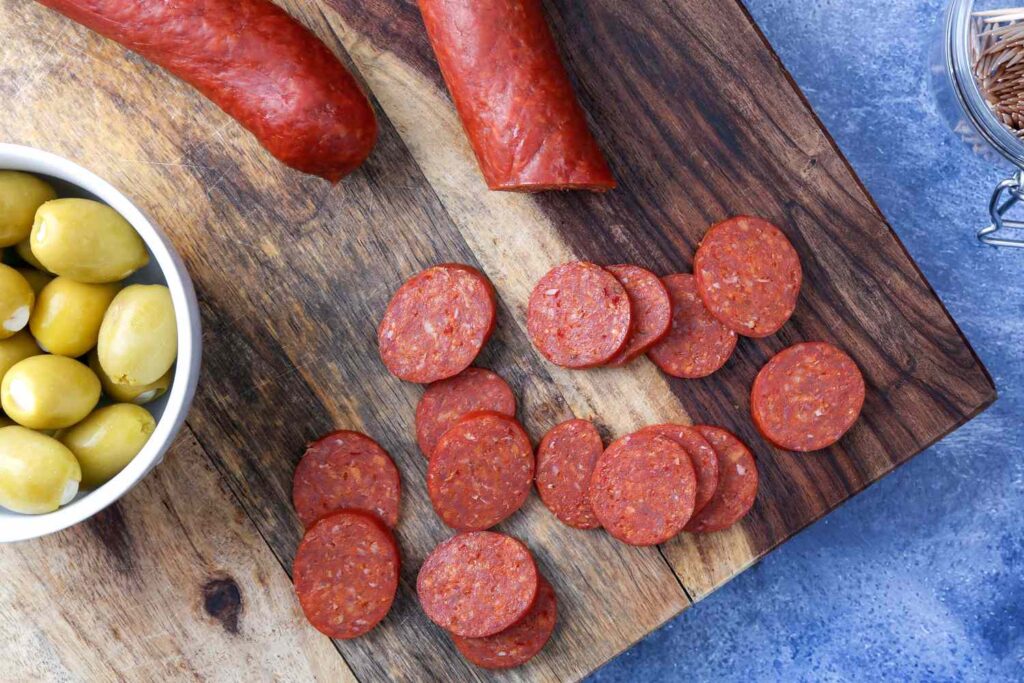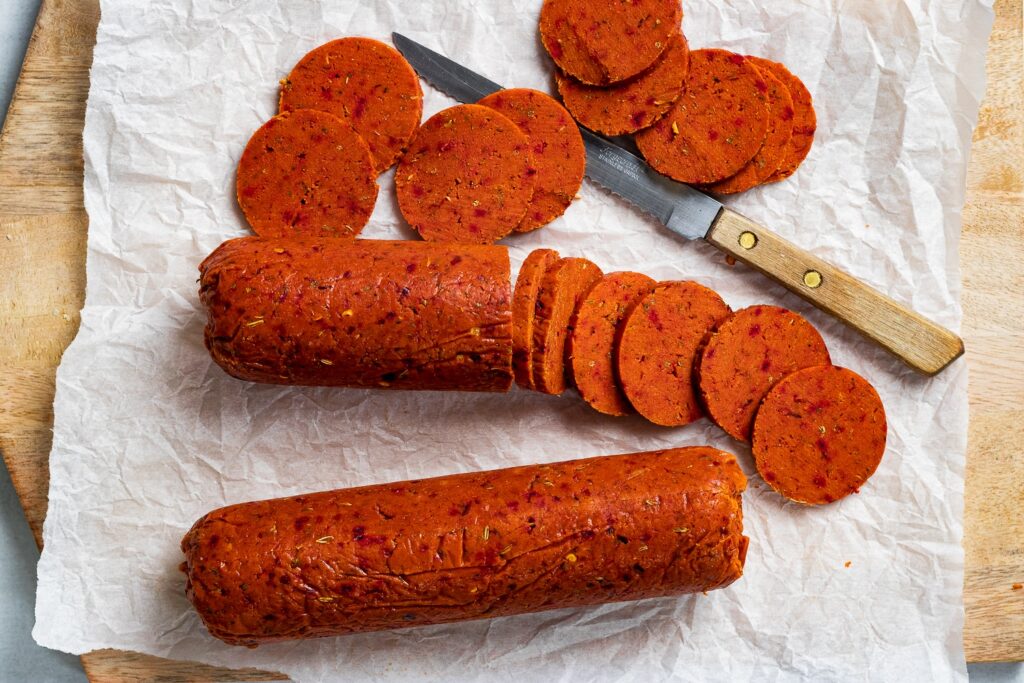When it comes to popular pizza toppings, few are as universally beloved as pepperoni. This savoury and slightly spicy cured meat adds a burst of flavour to pizzas, sandwiches, and various dishes. But ask yourself this, ‘what is pepperoni made of?‘

Delving into the ingredients and preparation of this versatile meat can reveal the secrets behind its delicious appeal. From its origins to the intricate process of creation, exploring what pepperoni is made of can lead to a deeper appreciation for this classic ingredient in the world of culinary delights.
Read Also: 10+ Worst Nigerian Food Combos You Should Definitely Try
Pepperoni: A Brief History
Pepperoni is a type of cured and seasoned Italian-American sausage that has become a staple in many cuisines, especially pizza. It is known for its distinctive flavour, reddish colour, and slightly spicy kick.
Traditionally made from a blend of pork and beef, pepperoni is seasoned with a mixture of spices, including paprika, red pepper flakes, garlic, and fennel seeds, which contribute to its characteristic taste and aroma.
Pepperoni is typically prepared by mixing ground meat with spices and curing agents, such as salt and sodium nitrite. The mixture is then stuffed into casings and fermented or air-dried to develop its flavour.
Once cured, the sausage can be sliced thin and added to pizzas, sandwiches, pasta dishes, and more. The combination of savoury meat and spices makes pepperoni popular for adding depth and a hint of heat to various culinary creations.
Over time, pepperoni has evolved to include variations such as turkey pepperoni for those seeking a leaner option and even vegetarian or plant-based versions that use ingredients like tofu or seitan to replicate the flavour and texture of traditional pepperoni.
Whether enjoyed on a classic pizza or used creatively in other dishes, pepperoni remains a beloved and iconic ingredient that has left its mark on the world of food.
Read Also: The Pizza Edition: A Comprehensive Review
Pepperoni as a Pizza
Pepperoni, the iconic Italian-American sausage, has achieved its own legendary status when it comes to pizza. A classic topping synonymous with this beloved dish, pepperoni pizza holds a special place in the hearts of many food enthusiasts worldwide.
A pepperoni pizza typically starts with a base of fresh dough, which is stretched and shaped into a round crust. A layer of rich tomato sauce is spread over the dough, followed by a generous amount of shredded mozzarella cheese.
Then comes the star of the show: slices of pepperoni are evenly scattered across the cheese-covered surface, ready to transform into crispy, flavorful morsels during the baking process.
Once the pizza is carefully assembled, it’s slid into a hot oven, where the crust turns golden, the cheese melts and bubbles and the pepperoni curls up slightly at the edges, releasing its aromatic oils. The result is a masterpiece that combines a symphony of textures and flavours.

The slightly spicy, smoky, and savoury notes of the pepperoni intermingle with the creamy cheese and tangy tomato sauce, creating a harmonious, comforting, and crave-inducing balance.
Pepperoni pizza has a way of transcending cultural boundaries, making it a popular choice on menus worldwide. Its simple yet irresistible combination of ingredients has earned it a place at family gatherings, parties, and casual meals alike.
Whether enjoyed in a bustling pizzeria or savoured at home, a slice of pepperoni pizza is a testament to the timeless appeal of this classic culinary creation.
Read Also: Tiffin Recipe: Discover the Secrets of Superb Cooking
What Is Pepperoni Made Of?
Pepperoni is a type of cured and seasoned meat, usually made from a blend of pork and beef. The exact ingredients and preparation methods can vary slightly depending on the manufacturer and regional preferences, but here’s a general overview of what pepperoni is made of:

- Meat Mixture: Traditional pepperoni is made from a mixture of finely ground pork and beef. The specific ratio of these meats can vary, but the combination adds depth of flavour and a balanced texture to the final product.
- Spices: A blend of spices is crucial to giving pepperoni its signature taste. Common spices include paprika, which gives the meat its characteristic red colour, and red pepper flakes for mild to moderate spiciness. Other spices like garlic powder, fennel seeds, black pepper, and sometimes cayenne pepper may also be added to enhance the flavour profile.
- Curing Agents: Salt and curing agents like sodium nitrite are used to preserve the meat, prevent spoilage, and create the cured texture of pepperoni. Curing agents also contribute to the characteristic pink colour that develops during curing.
- Flavour Enhancers: Some manufacturers might add flavour enhancers like monosodium glutamate (MSG) to intensify the savoury taste of the meat.
- Casings: The seasoned meat mixture is stuffed into casings, typically made from collagen or natural materials like hog or sheep intestine. Casings help the mixture hold its shape during curing and give pepperoni its characteristic round form.
- Curing and Drying: The pepperoni-filled casings are hung to air-dry and ferment after stuffing. This process allows the flavours to develop and intensify over time. The drying process also contributes to the finished pepperoni’s chewy and slightly firm texture.
- Slicing: Once the curing process is complete, the dried sausage is sliced into thin rounds. You commonly find these slices as toppings on pizzas and other dishes.
It’s important to note that while traditional pepperoni is made from pork and beef, variations are available, including turkey pepperoni for a leaner option and vegetarian or vegan pepperoni alternatives that use plant-based ingredients to replicate the taste and texture of the original meat-based version.
Read Also: How to make Sushi Burrito: Homemade Sushi Recipe
Homemade Pepperoni Recipe
Creating homemade pepperoni is a rewarding culinary adventure that allows you to customize flavours and enjoy a delicious product made from scratch. Here’s a basic homemade pepperoni recipe:

Ingredients:
- 2 pounds lean ground beef or pork
- 1 teaspoon curing salt (Prague Powder #2)
- 2 teaspoons paprika
- 1 teaspoon red pepper flakes (adjust to taste)
- 1 teaspoon garlic powder
- 1 teaspoon onion powder
- 1 teaspoon fennel seeds
- 1 teaspoon black pepper
- 1 teaspoon sugar
- Natural sausage casings (if desired)
The Types of Meat Commonly Used for Pepperoni
Pepperoni is traditionally made from a combination of pork and beef. The mixture of these two types of meat adds complexity to the flavour and texture of the pepperoni. The exact ratio of pork to beef can vary based on regional preferences and manufacturer recipes. Here’s a closer look at the types of meat commonly used for making pepperoni:
- Pork: Pork is a key ingredient in pepperoni, providing a rich and slightly fatty flavour and contributing to the overall taste profile. Different cuts of pork may be used, such as lean cuts of pork shoulder or pork butt. The fat content in pork helps keep the pepperoni moist during curing and drying.
- Beef: Beef is another important component of pepperoni, adding a hearty and robust flavour. Like pork, various cuts of beef can be used, such as lean beef chuck or sirloin. Beef also contributes to the overall texture of the pepperoni.
- Blends: The specific combination of pork and beef can vary, with some recipes using equal parts of both slices of meat, while others might lean more heavily towards one type. Blending the two portions of meat allows for a balanced flavour and texture that appeals to a wide range of tastes.
It’s worth noting that the meat’s quality greatly influences the final flavour and quality of the pepperoni. Lean cuts of meat are typically chosen to ensure a good balance of fat content for flavour and moisture.
The meats are ground to a fine consistency before being mixed with spices and other ingredients to create the distinctive flavour profile of pepperoni.
As dietary preferences and health considerations have evolved, some variations of pepperoni are made using leaner meats like turkey or chicken to offer a lighter alternative. These variations still aim to capture the spiciness and smoky flavour of traditional pork and beef pepperoni.
Additionally, vegetarian and vegan versions of pepperoni use plant-based ingredients to replicate the taste and texture of the original meat-based variety.
Read Also: Best Vegetarian Recipes Just for You
The Qualities that Make Each Meat Suitable for Curing and Flavour
Both pork and beef have specific qualities that make them suitable for curing and flavouring in the context of making pepperoni. These qualities contribute to the overall taste, texture, and appearance of the finished product:
Pork
- Flavour: Pork is known for its rich and slightly sweet flavour. The natural sweetness of pork complements the spices and seasonings used in pepperoni, creating a well-balanced and savoury taste.
- Fat Content: Pork is naturally fatty, and the fat content plays a crucial role in the flavour and moisture retention of the pepperoni during the curing and drying process. The rendered fat helps prevent the pepperoni from becoming too dry and contributes to its appealing texture.
- Texture: Pork has a tender texture that, when ground and cured, results in a desirable chewiness in pepperoni slices. The combination of meat and fat in pork gives pepperoni a juicy and satisfying bite.
Beef
- Flavour: Beef adds depth and robustness to the flavour profile of pepperoni. Its savoury and slightly more intense taste complement the other spices and ingredients, contributing to a more complex overall taste.
- Leaner Meat: Compared to pork, beef is generally leaner, containing less fat. While the fat content in beef may be lower, it still contributes to the overall texture and mouthfeel of the pepperoni.
- Texture: The leaner nature of beef provides a firmer texture to the pepperoni. This firmness complements the chewiness of pork and contributes to the characteristic bite of pepperoni slices.
In the context of pepperoni making, the combination of pork and beef allows for a balance of flavours and textures. Pork’s natural fat content helps keep the pepperoni moist during the curing process, while beef’s robust flavour adds depth to the overall taste.
The specific cuts of meat used and their fat-to-lean ratios can be adjusted to achieve the desired balance for each batch of pepperoni.
Ultimately, the qualities of both pork and beef come together to create the distinctive taste and texture that people associate with traditional pepperoni. The careful selection of high-quality cuts and the blending of these meats contribute to the final product’s deliciousness and appeal.
Read Also: Kid Cuisine: Healthy Recipes for Your Kids
Pepperoni Seasonings and Spices
The distinct flavour of pepperoni is achieved through a carefully selected blend of seasonings and spices. These ingredients enhance the meat’s taste and contribute to the overall aroma and character of pepperoni. Here are some common seasonings and spices used in making pepperoni:
- Paprika: Paprika is a key ingredient that gives pepperoni its signature reddish colour and a mild, smoky flavour. It also adds a subtle level of heat to the finished product.
- Red Pepper Flakes: Red pepper flakes or crushed red pepper are used to introduce a noticeable level of spiciness to pepperoni. The level of heat can be adjusted based on preferences.
- Fennel Seeds: Fennel seeds provide a distinctive aroma and a slightly sweet, liquorice-like flavour to pepperoni. They contribute to the unique taste profile of the sausage.
- Black Pepper: Ground black pepper adds depth and a bit of heat to the flavour. It complements the other spices and enhances the overall taste of the pepperoni.
- Garlic Powder: Garlic powder is used to infuse a savoury and aromatic garlic flavour into the meat. It enhances the overall complexity of the taste.
- Onion Powder: Onion powder contributes a mild onion flavour to the pepperoni. It adds depth and dimension to the overall taste profile.
- Oregano: Oregano is a herb that imparts a fresh and herbaceous aroma to pepperoni. It adds a layer of complexity to the overall flavour.
- Salt: Salt is crucial for enhancing the flavours and ensuring that the spices are evenly distributed throughout the meat.
- Sugar: A small amount of sugar may be added to balance the spiciness and acidity of the other ingredients, creating a more well-rounded flavour.
These seasonings and spices’ precise combination and ratio can vary based on regional preferences, manufacturer recipes, and personal taste. It’s important to note that the seasonings and spices are typically mixed with the ground meat before the pepperoni is stuffed into casings, allowing the flavours to evenly distribute as the meat cures.
The careful balance of these ingredients is what gives pepperoni its unmistakable taste and aroma. The right blend of spices enhances the meat’s natural flavours while creating a harmonious and savoury experience that is beloved by many, especially when it’s featured as a topping on pizzas or other dishes.
Read Also: Peri-Peri Chicken Recipe
Pepperoni Curing and Fermentation
Curing and fermentation are essential processes in producing pepperoni, contributing to its flavour and texture. These processes involve carefully controlling temperature, humidity, and time to transform the raw ingredients into the flavorful and shelf-stable pepperoni we enjoy. Here’s how curing and fermentation play a crucial role:
Curing
The initial step involves applying a mixture of salt, curing agents, and sometimes additional spices to the meat. This serves multiple purposes:
- Preservation: Salt helps remove moisture from the meat, creating an environment that inhibits the growth of harmful bacteria and microorganisms. This preservation method extends the shelf life of pepperoni.
- Flavour Enhancement: During curing, the meat absorbs salt and other seasonings, enhancing its overall flavour. The salt also contributes to the firm texture of the finished product.
- Texture Modification: Curing alters the protein structure of the meat, giving it a characteristic firmness that is ideal for slicing thin slices of pepperoni.
Fermentation
After the initial curing, the pepperoni mixture is allowed to ferment. This step involves controlled temperature and humidity conditions to encourage the growth of beneficial bacteria. The fermentation process:
- Acidification: Beneficial bacteria, such as lactic acid bacteria, convert sugars in the meat into lactic acid through fermentation. This acidification not only contributes to the tangy flavour of pepperoni but also helps lower the pH of the meat, further inhibiting the growth of harmful bacteria.
- Flavour Development: The metabolic activity of bacteria during fermentation produces compounds that contribute to the complex flavour profile of pepperoni. These compounds add depth and richness to the taste.
- Texture Enhancement: Fermentation helps break down proteins in the meat, leading to improved texture and tenderness. This is particularly important as pepperoni is meant to be easily chewable and enjoyable.
The duration of both curing and fermentation varies based on the desired flavour profile, texture, and regional preferences. Modern production methods often involve carefully controlled environments to ensure food safety and consistent results.
Once the curing and fermentation processes are complete, the pepperoni is typically stuffed into casings, shaped, and then further processed through cooking, smoking, or drying, depending on the specific type of pepperoni being produced.
In conclusion, curing and fermentation are integral steps in the production of pepperoni, allowing for the development of its distinctive flavour, texture, and shelf stability. These traditional techniques are combined with modern food safety practices.
This contributes to the creation of the well-loved pepperoni, that’s a favourite topping on pizzas and a versatile ingredient in various dishes.
Read Also: Mini Cheesecake Recipe: The Ingredients and How to Make Them
How Curing and Fermentation Enhance Flavour and Extend Shelf Life of Pepperoni
Curing and fermentation are crucial processes in the production of pepperoni that enhance its flavour and extend its shelf life. These processes work in tandem to transform the raw ingredients into a flavorful and safe-to-eat product:
Flavour Enhancement
Curing: During the curing process, a mixture of salt, curing agents, and spices is applied to the meat. Salt acts as a preservative, drawing out moisture from the meat. As the moisture is removed, the meat’s flavours concentration increases. The salt also penetrates the meat, evenly distributing the spices’ flavours and curing agents.
Fermentation: Fermentation involves the growth of beneficial bacteria, often lactic acid bacteria, on the surface of the meat. These bacteria convert sugars present in the meat into lactic acid and other compounds through metabolic processes.
These compounds contribute to the unique tangy and savoury flavour profile of pepperoni. The development of these flavours during fermentation adds depth and complexity to the overall taste.
Shelf Life Extension
Curing: The process of curing reduces the water activity within the meat. With less water available, the conditions become unfavourable for the growth of spoilage-causing bacteria and microorganisms.
As a result, the shelf life of the cured meat, including pepperoni, is extended. The salt in the curing mixture also helps inhibit the growth of harmful pathogens, contributing to food safety.
Fermentation: The fermentation process also plays a role in extending shelf life. The growth of lactic acid bacteria produces lactic acid, which lowers the pH of the meat. This decrease in pH creates an acidic environment that inhibits the growth of harmful bacteria and pathogens.
The combined effects of reduced water activity and increased acidity contribute to preserving the pepperoni and preventing spoilage.
Overall, the curing and fermentation processes work together to enhance the flavour of pepperoni by intensifying existing flavours and creating new ones through bacterial activity. Additionally, they create an environment that discourages the growth of spoilage-causing organisms, leading to an extended shelf life.
These traditional techniques and modern food safety practices ensure that pepperoni remains a flavorful, safe, and popular choice for pizzas and other culinary applications.
See Also: 21 Kerala Famous Food
Conclusion
Pepperoni is a beloved and versatile cured meat that brings its distinctive flavour and character to various dishes, most notably pizzas. Crafted from a blend of meats, typically beef and pork, pepperoni undergoes a careful seasoning, curing, fermentation, and drying process.
The use of curing salts and a blend of spices infuse it with flavour and contribute to its signature reddish hue. Through the art of fermentation, pepperoni’s flavours mature and develop while its texture transforms into the familiar chewy consistency.
Pepperoni’s journey from its raw ingredients to its flavorful finished form is a testament to the artistry of food preparation and preservation. Whether enjoyed as a pizza topping, in sandwiches, salads, or as a standalone snack, the allure of pepperoni lies in its rich history, distinct taste, and enduring popularity among food enthusiasts worldwide.
As we savour the delectable slices of pepperoni, we appreciate the combination of ingredients, techniques, and traditions that come together to create this timeless culinary delight.
FAQs for What is Pepperoni Made Of?
What is real pepperoni made of?
What is pepperoni made of? It is made up of a mixture of ground pork and beef mixed with spices and flavourings.
What kind of meat is pepperoni made from?
Its primary ingredient is ground beef and pork. Either meat is used in varying degrees, but pork is the most typical ingredient.
Where does pepperoni meat come from?
Turkey meat is also commonly used as a substitute, but the use of poultry in pepperoni must be appropriately labelled in the United States.
Is pepperoni red meat?
Technically, pepperoni is considered red meat because it is made from meat that comes from mammals, such as beef and pork. However, variations of pepperoni can be made from other meats, such as turkey, which would change the classification of the meat.
What does pepperoni taste like?
Pepperoni has a robust and flavorful taste that is slightly sweet, smoky, and spicy.
Are pepperonis good for you?
Pepperoni provides essential minerals and B vitamins that may positively impact overall health.
Can I eat pepperoni pregnant?
Pepperoni is safe to eat while pregnant – as long as it’s thoroughly cooked.
What is pepperoni used for?
It is generally sliced very thin and served as an appetizer, as a pizza topping, or as an ingredient for a variety of food dishes, such as pasta and meat.
